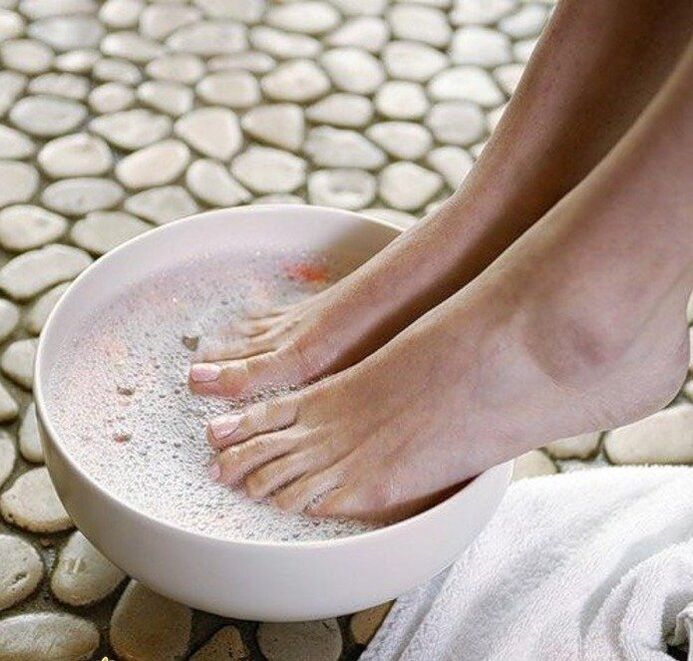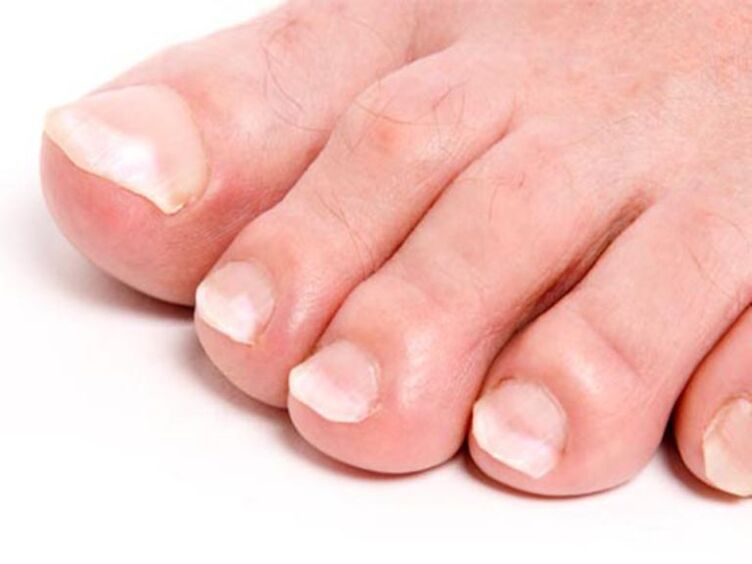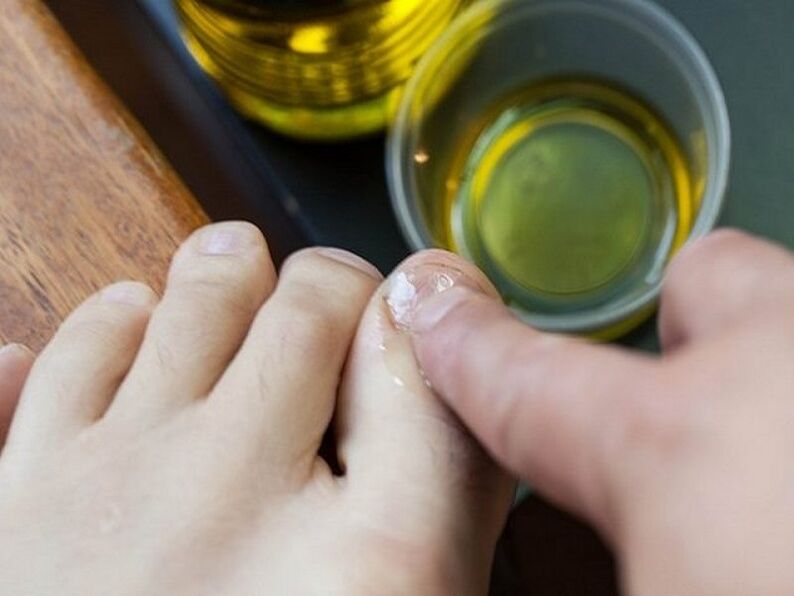
Nail fungus is a very unpleasant phenomenon. You can get this disease anywhere, especially in summer. But fighting with him often takes a lot of time. As statisticians have said, a quarter of the world’s population is suffering from this scourge. We will show you how to treat toenail fungus at home.
Vinegar for nail fungus
Few people know that vinegar can be used to solve the rather complicated medical problem of nail fungus elimination. Since edible vinegar (9% acid solution) or even vinegar essence (70% acid solution) can be purchased in hardware stores or in the market, there are many ways to use this product to treat toenail fungus.
Of course, vinegar self-medication should only be performed when the disease has not turned into a neglected form, and it is recommended to use it in combination with specially developed drugs.
However, when there is an urgent need to treat onychomycosis, and there is no money and time to see a doctor, and no medication, you can use vinegar yourself, mainly to comply with the corresponding safety rules.
Use characteristics of vinegar
The main effect of using vinegar is to create an acidic environment in the area of fungal infection and prevent the growth of hyphae and the spread of spores.
Gradually, fungi that cannot obtain new sources of nutrients will die, and no more cold-tolerant spores can prevent the possibility of disease recurrence.
At first glance, everything is simple-how to use preservatives to destroy bacteria. But in fact, this fungus is very tenacious, because its body is not located on the surface of the nail or skin, but enters the thickness of the tissue.
In this regard, positive results of the treatment of neoplasia should be expected only when the procedures are strictly regulated, which will not allow time for the recovery and penetration of the parasite under the skin.
Before treating nail fungus, make sure to use the same acetic acid concentration as indicated in the recipe.
If vinegar is mentioned in the formula, it means that 70% of the solution must be dissolved or applied point by point. Vinegar or vinegar contains 6% and 9% acid respectively. Ignoring these data will cause the treatment to end with chemical burns.
In addition, there are no special contraindications to the treatment with vinegar. Individual intolerance is very rare, but vinegar is such a common substance that usually patients know this characteristic of the body.
A burning sensation is likely to occur during the first operation, but this is normal and will disappear over time. Otherwise, according to safety rules, vinegar will not pose any threat to health.
Vinegar bath

A warm foot bath is considered to be an effective treatment against fungi; regular use can allow you to get rid of onychomycosis at an early stage without the need for additional medical treatment.
In addition, a vinegar bath is an excellent way to prevent fungal infections. This process requires about 50 degrees of warm water and a cup of 9% vinegar.
The water level in the basin should not be high, only to the ankle. Dip your feet in the solution and keep them for 15 minutes.
Before the vinegar bath, it is recommended to perform a complete pedicure procedure, including removing the affected nail plate and dead skin, calluses and corns on the feet, but do not apply decorative coatings on the nails.
If you cut and file your nails yourself, you need to be very careful, because micro-damages to the skin can lead to the spread of fungal infections.
Immediately after the vinegar bath, dry your feet with a towel and put on cotton socks. Repeat three times a week.
Vinegar lotion
Emulsion on areas affected by fungi is best done after the vinegar bath.
For this, medicinal products and pure 9% vinegar are suitable, in which a cotton pad is moistened and applied to the nails for 15 minutes.
A more complex formula: a mixture of vodka or 40% medical alcohol, glycerin and 70% acetic acid in equal proportions, mix until smooth.
The cotton swabs soaked in the solution were kept on the affected area for fifteen minutes, and then they put on socks made of cotton material. The course of treatment is one week, if necessary, it can be repeated a few days later.
Foot fungus ointment
All existing local preparations are based on the following active ingredients:
- Bifonazole
- Sertoconazole;
- Ketoconazole;
- Terbinafine
- Nafine;
- Hydroxyconazole;
- Cyclopyrrolamide.
The ointment for toenail fungus can only be selected after scraping the skin or the upper part of the nail. According to the analysis results, it can be clear which types of pathogenic microorganisms are the pathogens of fungal diseases:
- Epidermophyton
- Three tone
- Dermatophytes;
- Microspore
- Mold
- Mushrooms resembling yeast.
Based on the diagnosis, you should buy the best ointment that can deal with the detected fungal pathogens.
Antifungal ointment
All antifungal agents designed to remove nail fungus are divided into two groups:
- Allylamine. These drugs penetrate deep into the nail plate and completely destroy the fungal colonies. After a course of treatment, the accumulated concentration of active substances helps to resist recurrence for a long time, and healthy nails replace nail growth affected by fungus.
- Azole. They interfere with the synthesis of fungi by destroying their cell membranes. The effects of the accumulation of drugs in the nail plate lead to complete death from the infection.
If the affected area of the nail is relatively small, you can use special nail polish to remove the fungus.
These funds are used as regular pedicure varnishes and applied directly to the affected nails twice a week.
For prevention, healthy nails on adjacent fingers should also be varnished, because fungal spores spread very quickly and easily in the space.
Preparation procedure

These guidelines will help you use ointments more effectively against fungi.
- If the fungus infects multiple parts of your body, these parts should be treated at the same time to avoid recurrence of the disease.
- Apply the ointment not only to the affected nails or skin, but also to the area adjacent to them.
- During the application of ointment, pay attention to the hygiene of the skin and whole body.
- Before using the medicine, clean the affected area thoroughly with antibacterial soap under running water. Then take a softening bath. For this, dilute 1-2 tablets of nitrofural or potassium permanganate in 5 warm water. Soak your hands or feet in the solution for 10-15 minutes.
If there are no first signs of resolution of the disease after using the drug for several weeks, it is necessary to change the ointment and consult a dermatologist.
Ointment containing naftifine
An antifungal cream containing the active substance naftifine hydrochloride helps to destroy the structure of the infected cell wall. Penetrates into the deep layers of the skin. It also exists in the form of a solution.
It is used to treat various lichen fungi on feet, nails, and body. Apply this agent to affected, cleaned surfaces and adjacent areas once a day.
The duration of the course is from several weeks to eight weeks, and there are fungi on the skin. For nail infections, it is used several times a day for six months.
People who are allergic to naftifine should not be allowed. Sometimes it can cause redness and burning of the skin, but you should not interrupt treatment.
Terbinafine Ointment
One of the safest and most effective antifungal agents. Perhaps this is due to the active ingredient terbinafine.
Apply the ointment to the root of the nail and a thin layer of adjacent skin area and rub in. This process is repeated 1-2 times a day.
The course of treatment is 14 days to 1 month. Usually, the first result is visible after the first two weeks. If no improvement is observed, it is recommended to replace the drug with another drug. This medicine can be used for adults and children over 2 years of age.
Ketoconazole Ointment
This treatment is most effective against yeast infections, especially on the skin. Ketoconazole-the main active ingredient of the ointment, penetrates deep into the skin and directly acts on fungal cells, preventing them from multiplying and causing death.
Very good, because it can quickly relieve the symptoms of fungus. If the lesion is on the hand, use it once a day, if the lesion is on the leg, use it for up to two months.
Clotrimazole Ointment
An effective antifungal drug is a cream used to treat nail plates and skin. The main ingredient of the drug is clotrimazole, which destroys the membrane of the fungus, which can cause their death, and is applied to diseased nails twice a day.
The duration of treatment depends on the degree of development of the disease. But even after his symptoms disappear, treatment should be continued for one month.
If the individual is intolerant to its ingredients and liver disease, the ointment is contraindicated.
Inexpensive ointments: salicylic acid, zinc and sulfuric acid
Salicylic acid ointment can be used to successfully treat toenail fungus. It is used in two ways. In the first case, it will apply a thin layer to the affected area.
In the second case, use ointment and compress at night. After these procedures, the skin on the feet will begin to peel off strongly. Soap and soda bath will help speed up the peeling process.
Sulfur ointment is a time-tested medicine against nail fungus. Use it once a day at night for a week, and the concentration is prescribed by the doctor individually.
It is a powerful allergen, so it is necessary to test on healthy areas of the skin before use.
Tea tree oil fights fungi

Tea tree oil is an effective anti-cancer drug that directly acts on the cause of the disease-dermatophytes.
Tea tree essential oil contains α-terpinene, α-astragalus, limonene, acerene, cineole and other substances with antiseptic and anti-inflammatory properties.
Before using essential oils, you must perform an allergy test-apply a little product on the skin of your wrist. If there is no irritation or rash within 12 hours, the product can be used for medicinal purposes.
Otherwise, it must be diluted to a safe concentration, otherwise this technology must be completely abandoned.
How to use tea tree oil:
- Tea tree oil foot bath. Pour warm water into the basin to the height of your ankles, add 15-20 drops of essential oil, keep your feet in it for 20 minutes, and maintain a high water temperature (45-50 degrees). The course of treatment is two months, and you need to take a bath every day. During the treatment, it is necessary to use a file, nail clippers or scissors to remove the affected area of the nail plate.
- Apply oil on the nail plate. If you do not respond to undiluted tea tree oil, then in order to increase the effectiveness of the effect, apply it in its pure form to the affected area of the nail. In the past, the legs were steamed in warm water and laundry soap was added (for better dissolution, they could be grinded). Use a cotton swab to rub the oil on the nail plate twice a day without washing off the product.
How to cure toenail fungus quickly
Professor Neumyvakin described the internal and external uses of hydrogen peroxide for the treatment of infectious diseases and other diseases in a book based on personal experience.
He mentioned that hydrogen peroxide is a preventive agent with antibacterial properties.
The topical use of hydrogen peroxide to treat fungal infections is performed by steaming the feet with dissolved soda water at a rate of one teaspoon per liter in warm water.
When the nail plate becomes soft, use nail clippers to remove a small part of the affected area of the nail, and then soak it with a 3% peroxide solution and apply it to the nail plate.
Stay on the nails for 10-15 minutes and on the feet for 40 minutes to an hour. Perform this procedure twice a day until the symptoms of the fungal infection disappear.
In order to reduce the evaporation of peroxide and increase the impact strength, the nail plate with emulsion is wrapped in plastic wrap.
After the exposure time is over, rinse your toes and hands thoroughly under running water.
For treatment and prevention purposes, it is recommended to inject hydrogen peroxide into the nail cavity three times a day.
Soaking hands and feet with hydrogen peroxide (depending on the area of onychomycosis) will produce good results.
Dilute 3% hydrogen peroxide in 40-50 degree water at a ratio of two tablespoons per liter of water. The program time is fifteen minutes, and the regularity of the program is twice a week.
Other folk remedies
The comprehensive treatment of toenail fungus using folk recipes based on hydrogen peroxide allows you to eliminate the fungus and permanently get rid of unpleasant odors and other accompanying symptoms.
Two effective folk remedies for treating fungal infections:
- Peroxide-containing formula 1. To prepare the mixture, you need cooked soda (0. 5 cups), hot water (4 cups), 3% hydrogen peroxide (0. 25 cups) and half a cup of magnesium sulfate or Epsom salt. Mix all the ingredients thoroughly, then add a quarter cup of vinegar. Soak a cotton swab with the resulting solution, and then fix it on the nail plate affected by the fungus with plaster. The bandage needs to be changed every ten hours, and the course of treatment is one month.
- Peroxide formula 2. The process of treating fungi according to this formula consists of three stages. First, you need to prepare a solution for treating nails and skin surfaces affected by fungi—mix 3% vinegar and 3% peroxide in a 1: 1 ratio. When it fizzes, apply this mixture to your feet. The second stage is to immerse the fungal finger infected with the nail in a weak aqueous solution of bleach for half a minute, then rinse it thoroughly under running water and dry it with a towel. Finally, mix tea tree oil and petroleum jelly in equal proportions and apply it on the nail plate. Wear warm socks or gloves (if this technique is used to treat nail cancer). The course of treatment is one week.
- Nocaine lotion. A very simple but effective folk remedy for treating fungi is nocaine lotion. Simply soak a piece of cotton with nocaine and apply it to the fungus overnight. Only two such lotions are enough to get rid of the fungus forever.
- Apricot resin tincture: Remove 1 tablespoon of resin from the tree, pour into a cup of vodka, and leave it for three days. Use this solution to lubricate the skin of the feet and nails. Shake well before each use. It took us a month to treat. The affected nails were cut off as they peeled off, and new, healthy nails grew. After examination, the doctor confirmed that he had recovered. In this case, I can also recommend the old, thickened sunflower oil.
- Garlic application: I took a clove of garlic, squeezed it out with a garlic machine, applied the clumps to the nails, covered it with cellophane and wrapped it with a bandage or placed it on the fingertips. I kept using the bandage until the morning, and on the first day I felt a throbbing pain, like an abscess, but I had to endure it. Repeat these procedures every day and new nails will grow.
- Strong coffee. Few people know that regular but strong coffee is a good folk remedy for fungi. To make your coffee stronger, just dip your hands or feet into the cup, depending on where your fungus is. This procedure is best done before going to bed at night. After several such night operations, the fungus completely disappeared. At the same time, the skin became smooth and the pain quickly passed.
















